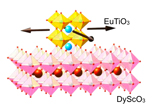 Ferroelectric ferromagnets are a holy grail of materials research, since they would enable electrically switchable magnetism with diverse potential applications in information technology, sensing and new “electro-magneto-mechanical” devices. Unfortunately, the few materials that have both ferroelectricity and ferromagnetism are very weak compared to those that exhibit only one or the other: their polarizations or magnetizations are 1000 times smaller. MRSEC researchers have developed a new route to ferroelectric ferromagnets: transform magnetically ordered insulators that are neither ferroelectric nor ferromagnetic (of which there are many) by stretching their lattice. For example, the material EuTiO3 was predicted to exhibit strong ferromagnetism and strong ferroelectricity when compressed in two dimensions. Experiments confirmed these predictions. New predictions promise materials which could function at room temperature, potentially opening up a new universe of applications for materials that simultaneously show both magnetic and electric order.
Ferroelectric ferromagnets are a holy grail of materials research, since they would enable electrically switchable magnetism with diverse potential applications in information technology, sensing and new “electro-magneto-mechanical” devices. Unfortunately, the few materials that have both ferroelectricity and ferromagnetism are very weak compared to those that exhibit only one or the other: their polarizations or magnetizations are 1000 times smaller. MRSEC researchers have developed a new route to ferroelectric ferromagnets: transform magnetically ordered insulators that are neither ferroelectric nor ferromagnetic (of which there are many) by stretching their lattice. For example, the material EuTiO3 was predicted to exhibit strong ferromagnetism and strong ferroelectricity when compressed in two dimensions. Experiments confirmed these predictions. New predictions promise materials which could function at room temperature, potentially opening up a new universe of applications for materials that simultaneously show both magnetic and electric order.
MRSEC DMR-0820404 and DMR-0507146 (Penn State), DMR-0520404 (Cornell), and DMR-0820414 (Ohio State)